
Jellyfish, also known sea jellies, are the medusa-phase of certain gelatinous members of the subphylum Medusozoa, which is a major part of the phylum Cnidaria.
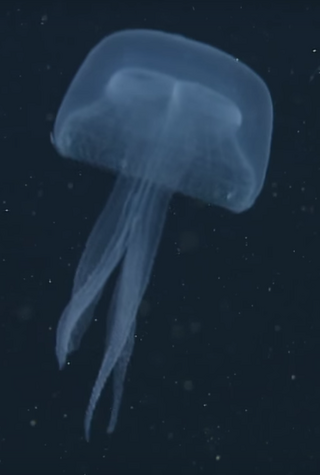
Stellamedusa is a genus of jellyfish. The genus is monotypic with a single species recognized, Stellamedusa ventana.

The lion's mane jellyfish, also known as the giant jellyfish, arctic red jellyfish, or the hair jelly, is one of the largest known species of jellyfish. Its range is confined to cold, boreal waters of the Arctic, northern Atlantic, and northern Pacific Oceans. It is common in the English Channel, Irish Sea, North Sea, and in western Scandinavian waters south to Kattegat and Øresund. It may also drift into the southwestern part of the Baltic Sea. Similar jellyfish – which may be the same species – are known to inhabit seas near Australia and New Zealand. The largest recorded specimen was measured off the coast of Massachusetts in 1865 and had a bell with a diameter of 210 centimetres and tentacles around 36.6 m (120 ft) long. Lion's mane jellyfish have been observed below 42°N latitude for some time in the larger bays of the East Coast of the United States.

Medusozoa is a clade in the phylum Cnidaria, and is often considered a subphylum. It includes the classes Hydrozoa, Scyphozoa, Staurozoa and Cubozoa, and possibly the parasitic Polypodiozoa. Medusozoans are distinguished by having a medusa stage in their often complex life cycle, a medusa typically being an umbrella-shaped body with stinging tentacles around the edge. With the exception of some Hydrozoa, all are called jellyfish in their free-swimming medusa phase.

Stauromedusae are the stalked jellyfishes. They are the sole living members of the class Staurozoa and belong to the medusozoa subphylum of Cnidaria. They are unique among medusa jellyfish in that they do not have an alternation of polyp and medusa life cycle phases, but are instead interpreted as an attached medusa stage, with a lifestyle more resembling that of polypoid forms. They have a generally trumpet-shaped body, oriented upside-down in comparison with other jellyfish, with the tentacles projecting upwards, and the stalk located in the centre of the umbrella.

Staurozoa is a class of Medusozoa, jellyfishes and hydrozoans. It has one extant order: Stauromedusae with a total of 50 known species. A fossil group called Conulariida has been proposed as a second order, although this is highly speculative. The extinct order is largely unknown and described as a possibly cnidarian clade of marine life with shell-like structures, the Conulariida. Staurozoans are small animals that live in marine environments, usually attached to seaweeds, rocks, or gravel. They have a large antitropical distribution, a majority found in boreal or polar, near-shore, and shallow waters. Few staurozoans are found in warmer tropical and subtropical water environments of the Atlantic, Indian, and Pacific Ocean basins, but most are known from the Northern Hemisphere. Over the years the number of discovered species has increased, with an estimated 50 species currently recognized. Information on Staurozoa is sparse, and it is one of the least studied groups within Cnidaria. While often neglected, correctly recognizing the characteristics of this class is crucial for understanding cnidarian evolution.
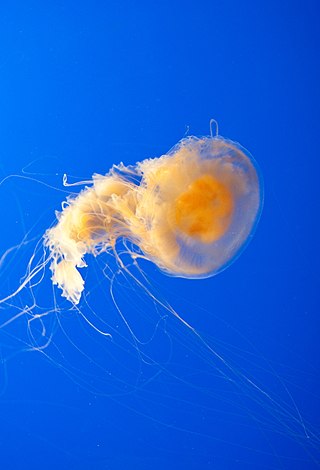
Phacellophora camtschatica, commonly known as the fried egg jellyfish or egg-yolk jellyfish, is a very large jellyfish in the family Phacellophoridae. This species can be easily identified by the yellow coloration in the center of its body which closely resembles an egg yolk, hence how it got its common name. Some individuals can have a bell close to 60 cm (2 ft) in diameter, and most individuals have 16 clusters of up to a few dozen tentacles, each up to 6 m (20 ft) long. A smaller jellyfish, Cotylorhiza tuberculata, typically found in warmer water, particularly in the Mediterranean Sea, is also popularly called a fried egg jellyfish. Also, P. camtschatica is sometimes confused with the Lion's mane jellyfish.

Deepstaria enigmatica is a very rarely seen giant jellyfish of the family Ulmaridae first described in 1967 by F. S. Russell.

The jelly blubber, also known as the blue blubber jellyfish, is a species of jellyfish from coastal regions in the Indo-Pacific. It is the most commonly encountered jellyfish along the Australian eastern coast and large swarms sometimes appear in estuarine waters.
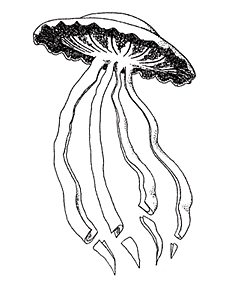
Stygiomedusa gigantea, commonly known as the giant phantom jelly, is the only species in the monotypic genus of deep sea jellyfish, Stygiomedusa. It is in the Ulmaridae family. With only around 110 sightings in 110 years, it is a jellyfish that is rarely seen, but believed to be widespread throughout the world, with the exception of the Arctic Ocean.
Calvadosia cruxmelitensis is a stalked jellyfish which inhabits the intertidal and sublittoral zones of rocky coasts in south-western England and the Atlantic coast of Ireland.

Haliclystus is a genus of stalked jellyfish that contains 11 species and one nomen nudum. It is the largest genus in the order Stauromedusae. Members of this genus are found in the Pacific, Atlantic, Indian, Arctic, and Southern oceans. Two members of this genus, Haliclystus kerguelensis and Haliclystus antarcticus, are found in the Southern hemisphere only. The remaining 9 members are found in the Northern hemisphere only.

Haliclystus auricula is a stalked jellyfish or Kaleidoscope jellyfish named for its shape resembling a funnel-shaped kaleidoscope that has eight arms typically found in the Northern Hemisphere. The Staurozoan is classified within the phylum Cnidaria under the kingdom Animalia. Under its genus, H. auricula is considered the type species.
Lucernaria janetae is an exceptionally large stalked jellyfish discovered on deep-sea hydrothermal vents on the East Pacific Rise in 2003 and described in 2005.
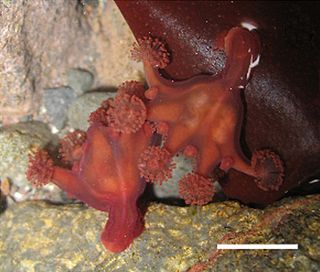
Haliclystus antarcticus is a stalked jellyfish which lives on rocky shore lines in the Southern hemisphere.

Lychnorhiza lucerna is a species of jellyfish in the order Rhizostomeae. It is found off the Atlantic coasts of South America.

Lipkea is a genus of stalked jellyfish. It is the only genus in the monotypic family Lipkeidae. Lipkea species lack tentacles at the end of their bell.

Copula is a monotypic genus of box jellyfish in the family Tripedaliidae of the phylum Cnidaria. The only species in the genus is Copula sivickisi, a very small gelatinous, bell-shaped jellyfish with four tentacles that is active only at night. It is unusual among box jellyfish in having a mating ritual and internal fertilization. Its scientific name honours the Lithuanian zoologist Pranciškus Baltrus Šivickis.
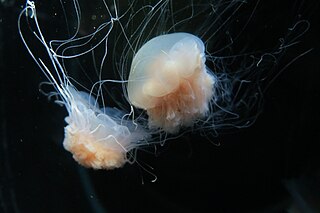
Cyanea nozakii or Cyanea nozaki (misspelling), commonly known as the ghost jellyfish, is a species of jellyfish found in the northern Pacific Ocean near the coasts of China and Japan. Along with other species of large jellyfish, it is showing a greater tendency to appear in large numbers and cause blooms.

Manania handi is a species of stalked jellyfish found in the Pacific Ocean along the west coast of North America. This species can be found in shallow waters at low tide on soft substrates such as seagrass (Phyllospadix), but the related M. gwilliami have also been recovered at depths of >10 metres. This may reflect that intertidal specimens represent the fringes of a population that is typically more commonly found in the subtidal zone.


















